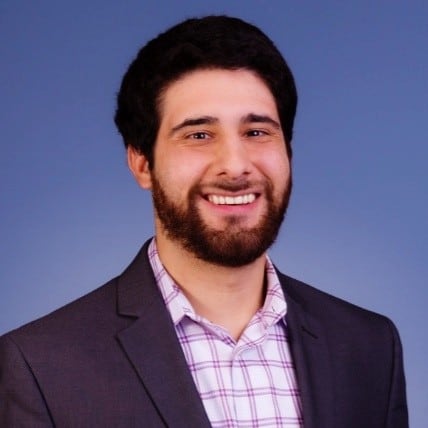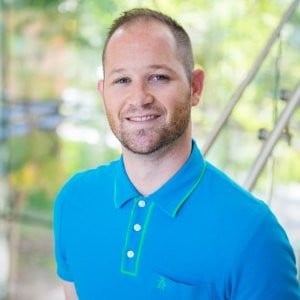Table of contents
No leads, no sales.
You know this.
And it’s why you work to drive traffic to your website — to identify and compel visitors who are likely to find value in your product or service, your tool or unique expertise.
Then, when the time is right, you work to convert those people in one of two ways:
- The “old” way, via a lead form
- The “new” way, via website chat
Or perhaps you use both?
In any case, your strategy will likely affect your conversion rate, your leads, and sales. Do you know which strategy works best? Does anyone?
Databox did some research to find out.
We asked a pool of entrepreneurs two questions:
Question 1: Which best describes your lead generation strategy?

Quantitatively, most entrepreneurs (approximately 50%) say that chat yields the highest on-site conversion rates. [Tweet this stat.]
That said…
Question 2: Where do you see better conversion rates?

…one third of respondents (approximately 33%) still use forms to convert visitors into leads.
Why the disconnect?
To answer this question, we also collected qualitative data, short answers that gave us a more well-rounded perspective.
Here’s what we learned about:
1.The case for CHAT
2.The case for FORMS
3.The case for BOTH
Let’s go.
*Editor’s note: Want to see which converts better on your website? We’ll make it easy and include some free templates here. If you’re a Drift user, grab this template and visualize your conversations in minutes. For all others, you can either track your conversion data in Google Analytics or HubSpot and compare.
PRO TIP: How to track these 10 popular Google Analytics 4 metrics
Sure, there are dozens (and dozens?) more Google Analytics 4 metrics you could track. But, starting with these 10 commonly tracked metrics will give you a pretty high-level view of how your marketing is working…
- Sessions: The number of sessions can tell you how many times people are returning to your website. Obviously, the higher the better.
- Sessions by organic keyword: Which organic keywords bring in the most traffic to your website? This may help you determine whether your SEO investments are paying off.
- Bounce rate: Do visitors leave shortly after landing on your website? Or do they stick around?
- Average session duration: How much time are people spending on your website? Users with a high average session duration are most likely relevant to your company.
- Goal completions: How many users responded to your call to action?
If you want to track these in Google Analytics, you might find the visualizations limiting. It’s also a bit time-consuming to combine all the metrics you need in one view.
To better understand how your website performs in terms of traffic growth and conversions, we’ve made this plug-and-play dashboard that contains all the essential metrics for understanding how successful you are at optimizing different aspects of your website.
You can easily set it up in just a few clicks – no coding required.
To set up the dashboard, follow these 3 simple steps:
Step 1: Get the template
Step 2: Connect your Google Analytics account with Databox.
Step 3: Watch your dashboard populate in seconds.
Chat: real people, real time
Bloop.
A box appears on your screen, in the bottom-right corner. It’s inviting, pastel blue with rounded edges. You purse your lips and blink. Then you click it, opening up a chat log.
“Hi there,” reads the text. “I’m Mary. How can I help?”
Mary’s a real person. You can tell because you see bubbles animating under her name as she types. You nod your chin, positioning your pointer fingers on the “F” and “J” keys of your keyboard.
“Hello,” you write. “Thanks so much. I do have a quick question, actually.”
Website Chat — whether it’s with a live human or a convincing bot — is attractive because it’s fast, efficient. People value speed and immediate gratification, now more than ever.
“There’s a psychological benefit to knowing that there’s a person who can be easily reached should questions arise,” explained Antonella Pisana of EyeFul Media. “Chat provides the instant gratification that people have come to expect.”
Here’s what our other respondents had to say about why they prefer generating leads via chat:

Ken Franzen
Neon Goldfish
One Tip: When possible, we prefer to have clients utilize a live chat tool (e.g., Drift, SnapEngage, PureChat) on landing pages and particular website pages like a pricing page.
We’ve seen an increase in conversions when this strategy is implemented. The live chat tool is usually used in conjunction with a form rather than replacing it.
We recently implemented this strategy for a Nursing School in Toledo, Ohio and saw an immediate 110% increase in leads. This school plans to create a chatbot answering the most common questions received through the live chat tool.
The reason we urge clients with resources to manage a chat tool is site visitors want instant gratification but still do not want to pick up the phone and call someone, lest they get sold by a slick salesperson. Through the live chat tool, the site visitor can immediately get their questions answered while still feeling like they have control over the conversation.
Hanging up on a phone conversation they don’t wish to participate is simply rude. Walking away from a live chat session when they’ve had enough doesn’t carry quite the same stigma. The site visitor recognizes this and feels more comfortable to engage with the company through this channel knowing they hold control over of the conversation.

AJ Alonzo
demandDrive
One Tip: I’d have to give the edge to website chat for this one.
There’s something about the real-time aspect of a web chat that increases conversion rates like no other.
And we’re no strangers to the idea of reaching out to form-fillers in a timely manner — but no matter how quickly you respond to someone who fills out a form, engaging with that prospect live is so much more impactful.
Pretty much 100% of the leads that come through our web chat convert into at least a discovery call, while prospects who fill out forms have a higher chance of going dark and never getting in touch with our sales team.
The key is connecting them to the sales team via email live – right while you’re chatting with them. That way they see the introduction come through as you’re speaking with them, and you’ve been able to address their top questions to help prepare the sales rep. Both parties get what they want!

Remington Begg
Impulse Creative
One Tip: One of the amazing things after implementing Drift for our Conversational Marketing initiatives was that forms were not cannibalized.
In fact, the chat widget received 1.5x more engagement/leads than the form — but forms still held steady.
That means by leveraging both tactics we were able to increase conversions by 2.5x.

Joshua Northcott
Hounder
One Tip: For us, as a digital design and development agency, our live chat service brings 75% of our lead generation on our website.
Our visitors like to ask us direct questions quickly and it has been one of our best lead generation tools.
We especially like it, because it allows us to start our relationship with a conversation within minutes of them learning who we are.

Lauren Crain
HealthLabs
One Tip: At our company, we started out using forms, but found that they weren’t converting.
The form page had a high bounce rate, and wasn’t leading to many conversions.
We then switched to live chat reps, and gave them the added incentive of bonuses with each sale.
We immediately started to see an uptick in conversions. Page visitors were more likely to engage with the live chat rep, and our reps were more likely to try and get the visitor to buy.

Chris Handy
ClosedWon
Editor’s note: Chris now leads customer marketing at Drift.
One Tip: While I do not believe that you have to shut down all the forms on your website to start increasing conversion, that’s what we did after starting to see most of our net new business coming from folks who first started a conversation with us in Drift messaging.
In fact, there was a string of months where 100% of our net new business came from people with whom I had never engaged with before a meeting I attended in Zoom — one they had scheduled themselves with our chatbot assistant in Drift.
Read that sentence one more time. I cannot stress that enough.
Offer your buyers as many ways to communicate with you and do business with you as you possibly can. Do not ignore this important channel.
Alex Melagrano
Drift
One Tip: Would you try to run a physical storefront without staffing employees to actively help customers purchase things and answer questions? Of course not.
Chatbots let you get things done faster and in a more human way.
If you’re dead set on forms, embed them in your chatbot.

Steve Latronica
SL Development
One Tip: We see live chat working best in service-based businesses (e.g., accounting, lending, law).
Live chat provides a way to capture a user’s attention as they are looking for help, which, in turn, provides an excellent opportunity to build trust. We find this helps qualify leads and can be a more effective conversion channel than web forms for the same reason.
A key part of a successful live chat implementation is the ability to staff the live chat with an effective operator who is prepared and trained to help convert users.
A failed live chat experience could mean losing that opportunity for good.
We pulled data from a few of our clients and found that on average live chat is converting 33%-50% higher than web forms.
Jesse Harrison
Employee Rights Lawyers
One Tip: I am the CEO and founder of the California Employee Rights Legal Group, and I’ve found that we generate more leads with website chats than forms.
The reason is simple: People have short attention spans today and they want answers right away. They don’t want to wait. Forms come to us in emails, and we get more than enough emails as it is. We may have to deal with current clients, insurance agents, retreats, collectors, doctors, and more, all via email; it is no wonder that sometimes, in all the confusion, requests from prospective clients are not answered promptly.
Instant chat, on the other hand, allows us to speak with clients in real time. We can answer their questions on the fly, and if we are not in the office, their answers will still come in the form of hired help. We know that it’s important for people to get answers as quickly as possible, and forms may take much too long. During normal work hours, we have someone on deck who will answer chat requests. In some cases, one of our attorneys will even step in directly to answer a question.
We have used chatbots before as well, but we found that users became dissatisfied and did not return to our website or reach out to us. They may have gone to another website or firm and moved on. Chatbots are still in their infancy and cannot be as helpful as a human yet.
For our firm, I believe that being able to answer tough questions immediately or within a reasonable amount of time is what separates us from others and what really makes us thrive. Per day, we may get anywhere between 50 and 100 questions, and we make sure to go through each and every one and provide an answer. We’ll get about a dozen clients per month who come to our firm because we gave them a fast answer via a chat window.
This instant turnaround is what separates live chat and forms or bots, and it can make all the difference in how many customers you sign up.

John Kelleher
ESM Inbound
One Tip: We get more form-fills than live chat conversations. That said, the live chat contacts tend to be better qualified and are more likely to become a customer on a shorter timescale.
In fairness, however, we have forms all over our site but live chat on bottom-of-the funnel pages.
If I had to choose between one or the other, then I’d go with forms.
Fortunately, in the real world, we can have both!

Antonella Pisani
One Tip: In my experience, chat is better for qualifying and closing leads than forms on most websites, especially when it is deployed at the right moment.
I believe that there is a psychological benefit of knowing that there’s a person who can be easily reached should questions arise, plus many people shop from work where they can’t (or don’t want to) take the time to make phone calls prior to making a purchase.
Plus, chat provides the instant gratification that people have come to expect — whereas it can take hours or days to receive a response from a form.
Chat can be triggered based on behavior, and can intercept the customers most likely to convert. At one company, we triggered chat when someone would enter a promo code that was invalid or didn’t apply to the order. This allowed us to close sales at a point where cart abandonment would usually be high. At another business, we triggered it for a luxury product and provided customers with a high touch feeling that they’d expect if they were making the same purchase in a store.
While website forms can be helpful to qualify B2B customers where there may be more lead time, I’ve seen this fail if customers are simply filling out data to receive a free gift. We saw a campaign for a higher priced staffing firm perform poorly because all people wanted was a free UX book. The amount of time their staff took to qualify leads likely would have been better spent answering chats on their site.

Andrei Vasilescu
DontPayFull
One Tip: When phones and emails were the modern ways to interact, lead capture forms on business websites were the only way for a potential customers to speak with any representative of the company.
The customer had to fill up certain forms and wait for hours, days, or even weeks to receive a phone call or an email from the company. It’s like asking a potential customer about their needs when he or she has already chosen the products from the respective racks inside a physical store.
Surveys revealed that only 2% of the people receive phone calls from the companies within 1 hour after submitting the relevant lead forms and more than 50% people never get any call at all. This is the most ridiculous way to generate prospective leads for businesses.
On the other hand, if you stay in most of the modern business websites for more than 10 seconds, inquiring messages will surface on the screen to guide you to what you need. You can instantly start conversing through these message boxes by writing texts and the AI-enabled chat bots will help you find what you’re looking for.
Basically, live chats on business websites are the most effective weapon to generate prospective leads.
Vince Lefton
Bulldog Adjusters
One Tip: Chatbots have worked so much better for us than forms because of the type of business we’re in: we offer free inspections for home damage.
Chatbots allow the homeowner to qualify us in real time.
Forms are great too, but as far getting quality leads, our chatbot has been the greater performer.
David Olson
HelpOnClick
One Tip: Live chat provides a greater opportunity for leads than the standard website contact form.
Potential customers are more inclined to reach out via chat because they have the ability to get their queries answered in real time.
Live chat also gives CSRs the chance to address any concerns that may drive a customer away.
In our experience, over 90% of inquiries come via live chat while less than 10% prefer the contact form.
Greg Hamblin
Clear Counsel Law Group
One Tip: I’ve been making websites for a long time and a lot of those have been for service-focused companies. In the service industry, we often use ad campaigns to drive users to custom landing pages that heavily feature a contact form and phone number. That works great for traffic generated by ads, where the site visitor already has “intent” to buy and so is more motivated to fill out a form or pick up the phone.
But what about elsewhere on your site?
Here’s an example: One of my law firm clients has a deep reservoir of blog posts that generate a decent amount of traffic. However, a simple look at their analytics showed that most people would read the blog content, then slip away without making contact. Adding a form to the page was one idea, but from previous experience, I knew it wasn’t likely to generate any additional clients.
A chat function, with low intrusiveness, managed to capture 4 to 5 additional daily leads from the blog posts that normally would have been people who just left the site.
A word about the quality of leads: There is a definite difference in the quality of leads you get from a chat function than from a web form. Web form submissions, particularly from custom landing pages, are relevant and “warm leads” because their intent matches the service you’re looking to promote. Chat sessions from blog pages may be from people who don’t have an interest in your service, but who are simply researching.
If you enable a chat function on your site, expect to spend much more time answering “quick questions” and responding to people who have no interest in your service.
In my law firm example, we would see about 20% of chat sessions were what we would consider “warm” leads, as opposed to about 70% of web form submissions.
Forms: The old way, the easy way
Click.
The form you just interacted with comes to life, instantly populating several fields with your name, your email, your company and title.
Thanks, LinkedIn, you think. That was easy.
You take about eight seconds to fill in the “Reason for Contact” field.
“I’d like a demo,” you write. Then you press the big, orange “SUBMIT” button. Done.
Forms — long or short — are what most people know and understand. Forms are the standard, the accepted norm. Everyone, at some point, has filled out a form. Everyone.
And inertia is a powerful force. It’s hard to stop a train.
They’re also associated with value: kickbacks, rewards, content. People are conditioned to check their email after filling out a form — and it’s usually a good experience.
“Forms generate more leads for my websites because my customers love to download freebies,” explained Maristellas Colombo of eBooks4Fashion. “It could be a PDF or a video or a free sample.”
Here’s what our other respondents had to say about why they prefer generating leads via chat:

Maristella Colombo
Maiden-Art di Maristella Colombo
One Tip: Forms generate more leads for my websites because my customers love to download a freebie, that could be a pdf or videos or receiving free samples with giveaways.
So forms work best across both of my fashion businesses websites.

Gaines Murfee
Chili Piper
One Tip: Forms. When somebody submits a form, that’s a pretty big commitment.
Chat is great as well, but I often find people just chat, ask a few questions, and then bounce.
Sometimes you don’t get their info and there isn’t a great way to handle objections on chat. Plus, if you’re not a dedicated to answering chats, the interruption can be distracting.

Scott Haney
Chili Piper
One Tip: We find that significantly more leads and deals come from the forms on our site.
Chat has been a good supplement though. People usually ask us questions there and once they get all the info they need, they tend to fill out a form (even if we ask them if they’d like to book a demo with us within the chat).
We can also qualify leads through our web form integrations, so we find that’s a much stronger way to schedule qualified meetings.
Seb Dean
Imaginaire Digital
One Tip: On the whole, we work with B2B companies offering local services, so I imagine the stats are quite different in the SaaS space, for instance.
Overall, we’ve seen extremely low uptake whenever we’ve implemented live chat for clients — the only exception being for ecommerce clients.
For a normal B2B client, we’ve seen conversion rates of around 1% for live chat while forms convert at about 7% on average.
For ecommerce clients we’ve seen higher rates, with a general benchmark being around 5% for live chat.
Despite the low conversion rate for B2B sites, we still think it’s useful as it tends to open dialog with potential customers that need clarification on things before committing to a ‘proper’ enquiry.

Ryan Bloms
Codal
One Tip: At Codal, we generate more qualified leads through our website form than we do through our chatbot.
While we have seen an increase in messages since we’ve switched to a Drift-powered bot, the messages can be random and sometimes people are pitching to us instead of asking about our services. When people take the time to fill out our website form, they’re more likely to actually want our services and fit our requirements.
On an average day, my time spent talking to leads from our website form is more likely to head towards a project. In comparison, sometimes the person messaging me through our chatbot just says ‘hi’. That’s not a lead, it’s just junk. I have to spend time figuring out what they want – when a lot of the time it’s just curiosity.
It’s not that the chatbot is bad, it’s just that many of the people using it aren’t as serious about a website design.

Ilan Kasan
Exceed.ai
One Tip: Exceed.ai is conversational AI solution for B2B lead capturing, qualification and nurturing that helps sales team land more qualified opportunities.
One of our products is a conversational form, which is designed to replace traditional forms with a chat-like experience embedded into landing page.
Our customers have seen consistently high conversion rate from website visitors to qualified leads using the chat experience.
Yet, it doesn’t always make sense to replace a form with a chat experience. If you are just looking for 2-3 data fields, and looking to get as many contacts as possible, you probably want to stick with the form.
If, on the other hand, you are looking to collect more fields and also make sure to filter our unqualified leads, we recommend a conversational form. The reason is that a conversational experience can adapt the questions asks based on what we know about the lead and it give the lead an opportunity to ask questions and engage.

Joshua Ho
Referral Rock
One Tip: Overall I think it’s less of a forms vs chat argument but the ideal strategy would be to have both.
Here are numbers from our 3 main lead entry points, where we get full contact info and intent to engage with us about our product:
1) Chat 6%
2) Demo Request Form 44%
3) Trial Signup 50%
If I had to pick one, I’d pick forms. Chat can add a lift, but forms aren’t going to be replaced.
Not everyone wants to have a conversation at the first entry point.
My opinion is that what matters is how responsive a business is.
One can still be responsive, personal, and human without chat. The traditional form lead, however, doesn’t get a quick response.

Christoph Seitz
CFR Rinkens
One Tip: Until recently, we were only using a website chat feature. We realized we might not be capturing our full lead potential. We implemented a website form on each of our service pages. It’s a quote request form that allows the customer to input all of their data in exchange for a price estimate on car shipping.
Last month, 104 conversations were initiated via the chat feature. Only about half of those were qualified leads.
Comparatively, we received 226 leads from our price estimate form. As you might imagine, all of those were qualified leads. We will keep both features because they both work, and they both generate leads. However, if we had to only choose one, I certainly go with our website form.
John Holloway
One Tip: In my experience, forms have outperformed chat by a long shot.
Most of our users want to avoid needing to speak to someone. We found that less than 1% of visitors participated in a chat, where over 60% of visitors completed a form. I think it’s something that should be tested, as every business is different.
What makes our company unique is we offer life insurance without the pushy sales agent. So naturally, people avoid the live chat.
Our lead generation strategy involves lots of inbound marketing. We try to get in front of the visitor when they are searching for information on life insurance. In my opinion, if the visitor is towards the end of the buying funnel they tend to know what they want, and they do not need any help from chat. We ended up removing live chat, as it was slowing down our landing page load time and hurting our conversion rate more than it was helping.

Jennifer Noto
Carolinas IT
One Tip: We’ve been using an online contact form on every page of our website for many years.
About 2½ years ago, we implemented LiveChat on our website as an additional tool to generate leads.
The platform generated over $20,000 in revenue and paid for itself for over six years. Over the last two years, our SEO has greatly improved, resulting in a higher rate of lead generation through our website.
Our website generates a higher number of leads as well as a higher rate of conversion due to the high SEO rankings we’ve achieved. We are finding that most people who contact us on the chat program are looking for technical support rather than information about our service offerings.
We’re considering implementing technical support via chat in the future.
Both: After all, why not?
If chat is instant and human while forms are familiar and comfortable, then they’re both somehow good. So why not use both?
Why not let the user land on the experience she’s most comfortable with, most accustomed to?
“Offer the buyer as many ways to communicate with you and do business with you as you possibly can,” explained Chris Handy of ClosedWon.
Here’s what our other respondents had to say about why they prefer generating leads via chat:

Jonathan Aufray
Growth Hackers
One Tip: This is a tricky question because the right answer is: it depends on your industry, market and target audience.
In some sectors, we found that website forms converted better than chat boxes and sometimes chat boxes convert better.
I’d like to add that you need to test both for your business and see what gives the best results. Also, you don’t want to analyze the number of leads you get but also the quality. We found that you may generate more leads from a web chat but the leads could be more qualified from a popup form.

Matthew Wainwright
ipswitch
One Tip: Generating: forms, no contest. Qualifying: chats have been moving up in terms of the actual opportunities generated from and possibly even sales.
In one of our LOBs, Chat is exceeding “Contact Sales” in terms of influence in opportunities generated.
Evals are still king there. Without a doubt chat has exceeded PPC and tradeshows. 5 years ago, those were very powerful lead generation tactics.

Mike Kamo
Hello Bar
One Tip: When it comes to lead generation, there is no one-size-fits-all approach.
This means that while one company might find enormous benefit in using website forms, another company might benefit more from using a chat bot. However, both companies will see the greatest increase in lead generation, and in turn increase in revenue, from strategically using both tools in combination.
Many people set up their lead generation tools as if they’re setting up a new design feature. They look for tools that are pleasing to the eye, function on a surface level, and at the end of the day, require little maintenance. But, just like any marketing tool, lead generation software must be optimized – and that means looking at a few different things.
The first step to maximizing your lead generation attempts is to take a look at your sales funnel. It’s no help to place a lead generation form or chatbot where your customers aren’t – you need to find the gaps in your site – we suggest using heat mapping software like Crazy Egg that lets you see exactly how users interact with your site.
Once you’ve identified where to place your lead generation tool, you can decide which one to use. For example, if you’re noticing that a lot of people are coming to your site and leaving rapidly (ie. you have a high bounce rate), a lead generation form would be your best bet as you can optimize them to deploy whenever your user goes to exit the site by clicking the top url bar. These are called exit intent page takeovers, and they have some pretty incredible results.
We recently tested an exit intent page takeover on our site and picked up an additional 875 sign ups in the month of June alone with a goal completion rate of 17.8% (our standard is 1.48%), so we are definitely getting some great results.
If your site isn’t suffering from a high bounce rate and your visitors are scrolling more leisurely through your site, that might be the time to use a chatbot. Or, if you have a lot of customer support inquiries, a chatbot will make natural sense.
Lead generation forms and chatbots, while similar, can and should be used differently. Taking the time to create strategies around how to use them in combination pays off big time and can cost very little. Many lead generation software, like Hello Bar, offer free trials or plans.

Ally Compeau
Woof Signs
One Tip: You may be capturing potential customers at different points in the buying process. We have noticed that that chat function on our website acts as a great way for customers to ask quick questions about our product offering and if we’re able to help with the particular need. Customers are in more of a discovery phase at this point. Alternatively, we find that most customers who are leveraging our form functionality, are using it to actually request a quote. They are at the point in their buying process where they are ready to purchase and are looking at pricing.
You may be capturing different types of consumers based on their communication preferences. One thing we have also noticed is that there aren’t any customers who use both the chat function and the form function simultaneously. Some customers may want an immediate response and have the time on hand to engage in a live chat to get their answers. Other customers may want to send their question/inquiry quickly via a form and then review the response at a later time, especially if they are looking for responses to compare from multiple firms.
Adding chat in addition to a form may help with team efficiency. Often times, answering customer questions via email can be onerous because the responses need to be all-encompassing due to the lack of ability to converse with the customer and ask any questions you may have. You essentially have one shot to get the right answer to the customer and cannot bank on them responding. Therefore, these responses generally take up quite a bit of time. With the addition of a chat function, we have found that we can quickly answer one-off questions that might take much more time via a form/email. It also offers an opportunity to engage the customer real-time and ask the questions we need to provide the best answer and service.
Our advice:
While we’re tempted to say that forms are dying and chat is taking their place, we know better.
We know that every industry and discipline is different. We also know that no two audiences are alike.
So, as always, follow the data provided by your lead generation dashboard. Lean into it, trust it.
What else can you do?
Want more? In one of the episodes of Metrics&Chill John and Pete debate the differences in approach, the pros and cons of each, and more.














